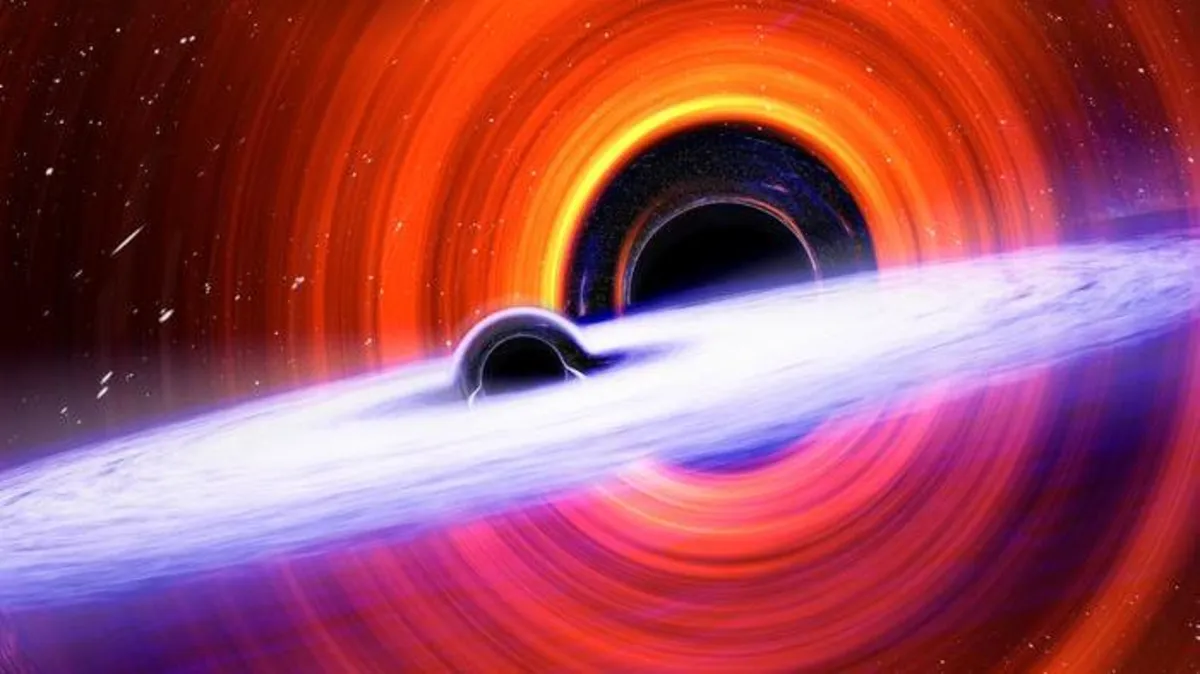
Recent advancements in astrophysics have led scientists to detect the symphony of two newborn black holes, each formed from the violent collision and merger of their respective parent black holes. This groundbreaking discovery marks the first time such an event has been detected in history. The information about these baby black holes, along with details regarding their four parent black holes, was obtained through the observation of gravitational waves—ripples in spacetime produced by these cosmic cataclysms.
The remarkable findings were made possible by the collaborative efforts of LIGO (Laser Interferometer Gravitational-Wave Observatory), Virgo, and KAGRA (Kamioka Gravitational Wave Detector). The first merger event, designated as GW241011, was detected on October 11, 2024. This event involved a black hole with a mass approximately 17 times that of the sun colliding with a partner black hole weighing around seven solar masses, approximately 700 million light-years away from Earth.
The analysis of the gravitational wave signal from this event provided crucial insights, including the masses of the involved black holes and the revelation that the larger black hole is one of the most rapidly spinning black holes ever documented.
Less than a month after this initial detection, another significant gravitational wave signal, designated GW241110, was recorded on November 11, 2024. This signal originated from a collision between black holes with masses of 16 and eight solar masses, occurring about 2.4 billion light-years from our planet. Notably, this event showcased a unique characteristic: one of the black holes was spinning in the opposite direction of its orbit around its companion, marking a historic first in the observation of merging binary black holes.
Each new detection of these black hole mergers offers invaluable insights into the universe. As Carl-Johan Haster, an assistant professor of astrophysics at the University of Nevada, Las Vegas (UNLV), pointed out, every observed merger not only represents a significant astrophysical discovery but also serves as a critical laboratory for testing the fundamental laws of physics. While previous observations had predicted the existence of binary black holes, these findings provide the first direct evidence supporting their existence.
According to Stephen Fairhurst, spokesperson for the LIGO Collaboration and a professor at Cardiff University, both GW241011 and GW241110 are among the most novel events detected within the extensive catalogue of observations made by the LIGO-Virgo-KAGRA network. The presence of rapidly spinning black holes in both events suggests they may be the result of previous black hole mergers, hinting at the existence of so-called second-generation black holes.
The classification of these detected black holes as second-generation stems from the significant mass difference between the larger black holes and their smaller counterparts in the two mergers. The smaller black holes appear to be nearly half the mass of their larger companions. Additionally, the unique spin direction of the larger black hole in the GW241110 merger further supports the idea that it originated from a prior merger, illustrating the hierarchical process of black hole growth through successive collisions.
The GW241011 event offers scientists a vital opportunity to explore the limits of Einstein's 1915 theory of gravity, known as general relativity. The rapid rotation of the black hole involved in this merger distorts the object, leaving a distinct imprint on the gravitational waves it emits. This allows for comparisons between the event and theoretical predictions made by physicist Roy Kerr regarding rotating black holes. Remarkably, the black holes observed in GW241011 align with Kerr's solutions to general relativity, providing further validation of Einstein’s groundbreaking theory under extreme conditions.
This event has also confirmed the presence of higher harmonics in the gravitational wave signal, akin to the overtones produced by musical instruments—a phenomenon observed for the third time in gravitational wave signals. Moreover, the LIGO-Virgo-KAGRA collaboration believes that these signals may hold the key to uncovering phenomena predicted by physics but never previously observed, including potential evidence beyond the boundaries of general relativity.
Interestingly, the two black hole mergers also have implications for the field of particle physics. Scientists theorize that rapidly rotating black holes could be instrumental in testing the existence of ultralight bosons—hypothetical particles that lie beyond the Standard Model of particle physics. If these particles exist, they could extract rotational energy from spinning black holes, with the extent of energy extraction dependent on their mass. The ongoing rotation of the progenitor black hole from the GW241011 merger, even after millions or billions of years, seems to challenge a range of possible ultralight boson masses.
The detection and analysis of these two significant events emphasize the importance of operating gravitational wave detectors in synergy and enhancing their sensitivity. According to Francesco Pannarale, co-chair of the Observational Science Division of the LIGO-Virgo-KAGRA Collaborations and a professor at Sapienza University of Rome, the advancements made through the LIGO and Virgo instruments have deepened our understanding of how black hole binaries form in the universe and the fundamental physics that governs them. By upgrading our instruments, researchers aim to explore these phenomena with increased precision, paving the way for future discoveries in black hole astrophysics.